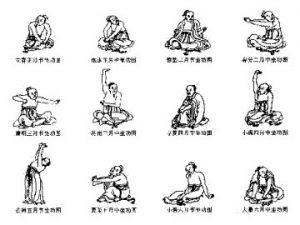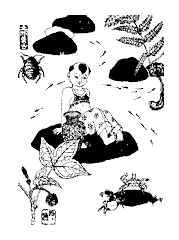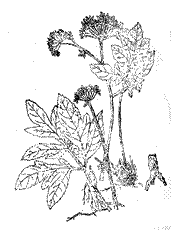Treating Mutiple Sclerosis (MS) With Herbal Therapy Amyotrophy Convalescence Pill Series
1. The General
Multiple Sclerosis (MS) is a disease that affects patients’ entire lives, both physically and psychologically.
Physically, the brain and the spinal cord are involved. Specifically, degeneration of myelin, a material which is composed mainly of fats and serves as an insulation for the nerves, much like the covering of an electric wire, degenerates. This fatty insulation allows a nerve to transmit its impulses with lightning-like speed, enabling people to move almost without thinking. The loss of this myelin insulation causes what is, in effect, a short-circuiting so that a person loses the ability to make smooth, rapid, and coordinated movements. Thus, MS is a demyelinating disease. With multiple sclerosis, the loss of myelin appears to the naked eye as a hardened sclerotic (scar) area. These areas are multiple within the central nervous system, thus the term multiple sclerosis. Different areas of the brain and spinal cord are responsible for different kinds of movements. For example, the cerebellum, an out-pocketing of the brain, is responsible for making coordinated movements. When an area of demyelination occurs in the cerebellum, coordinated movements become difficult. The neurological deficit is quite dependent on the region of the brain or spinal cord that has been affected.
| Video: What is Multiple Sclerosis? |
2. What is MS?MS is thought to be an autoimmune disease, which means that your own immune system mistakenly attacks normal tissues in your body. In MS, these attacks are aimed at the myelin in the central nervous system.
The central nervous system, which includes the brain and spinal cord, is made up of nerves that act as the body’s messenger system. Each nerve is covered by a fatty substance called myelin, which insulates the nerves and helps in the transmission of nerve impulses, or messages between the brain and other parts of the body.
MS gets its name from the buildup of scar tissue (sclerosis) located in more than one area (multiple) of the brain and/or spinal cord. Plaques form when the protective myelin sheath is destroyed, a process called demyelination. Without the myelin, signals transmitted throughout the central nervous system are disrupted or halted. The brain then becomes unable to send and receive messages.
Although the nerves can regain myelin, this process is not fast enough to outpace the deterioration that occurs. The types of symptoms, severity of symptoms, and the course of MS vary widely, partly due to the location of the scar tissue and the extent of demyelination.
3. What are the Symptoms?The initial symptoms of MS are most often:
| 1 | Difficulty in walking; |
| 2 | Abnormal sensations such as numbness or “pins and needles”; and |
| 3 | Pain and loss of vision due to optic neuritis, an inflammation of the optic nerve. |
Less common initial symptoms may include
| 1 | Tremor | |
| 2 | Incoordination | |
| 3 | Slurred speech | |
| 4 | Sudden onset of paralysis, similar to a stroke; and | |
| 5 | A decline in cognitive function¡ªthe ability to think, reason, and remember | |
4. What causes MS?MS is very complex. The cause of MS is not a single thing but a coming together of a certain genetic predisposition, certain environmental contacts, probably early in life, and perhaps certain other factors that we really only partially know about today.
We do know certain things about MS. We know that people with certain tissue types, from certain hereditary backgrounds are more likely to get MS,
We know that there is some likely environmental contact or contacts early growing up, and we know that the disease is mediated in large part through the immune system. The immune system is what then alters the response to foreign materials in the body and appears to be attacking the myelin or the coating of the nerves around the axons in the brain and in the spinal cord.
Some new information that actually [came out] within the last few months, is that there is more going on in MS than just meets the clinical picture. In other words, when patients are clinically stable, they may have disease working on their body, just not being manifest. We learned a few years back with the development of MRI that MS appeared to have more active MRI lesions than it appeared to have clinical exacerbations. But we now know that biochemically with some new tests such as Magnetic Resonance Spectroscopy, or MRS, that there is much more steady activity in more areas of the body than even show up in the most recent type of MRI testing.
We’re learning more and more about MS all the time, but we still have a ways to go. Fortunately, we now have some treatments that are at least starting to alter the course of MS.
5. How to DiagnoseThe diagnosis of multiple sclerosis is usually made as a result of clinical symptoms and a neurological examination. There is no one laboratory test which the clinician can use to make a firm diagnosis. However, in two-thirds of the cases of multiple sclerosis, an elevated gamma globulin is noted in the spinal fluid. Special proteins called oligoclonal bands are found in the spinal fluid of 80 percent of people with MS. Special studies looking at Igg production can be performed.
Electrical tests may indicate short-circuiting in the central nervous system. These are called evoked response tests because a response from the nervous system is evoked with a specific stimulus. The stimulus may be visual, auditory, or through stimulation of an arm or leg. If it takes the stimulus an unusually long time to reach the brain, a short-circuiting may be the cause.
Magnetic resonance imaging (MRI) allows the brain to be seen without surgery. MRI is particularly sensitive to MS, thus it has become an important aid to diagnosis. It is important to realize that other processes can make an MRI abnormal, and that it can miss MS every now and then. For more information please click Multiple Sclerosis.
6. Treatment by Western medicine
| 6-1 | Corticosteroids For those with progressive MS, treatment is aimed mainly at relieving symptoms. Oral or intravenous corticosteroids are most often prescribed to reduce inflammation in nerve tissue and shorten the duration of flare-ups. Prolonged use of these medications, however, may be associated with side effects such as osteoporosis and hypertension. |
|
| 6-2 |
Beta interferons Avonex is administered once a week by intramuscular injection. Betaseron and Avonex each have been shown in clinical trials to reduce flares of MS by up to 30 percent. Their exact therapeutic mechanism and long-term benefit aren’t fully understood. |
|
| 6-3 | Glatiramer acetate (Copaxone) The FDA recently approved an alternative to beta interferons for those with relapsing-remitting MS. Glatiramer acetate (Copaxone), formerly known as copolymer-1, has been shown to be as effective as beta interferons in curbing MS attacks. It’s believed that Copaxone works by blocking the autoimmune attack on myelin. |
|
| 6-4 | Tizanidine hydrochloride (Zanaflex) Another advance in the fight against MS is tizanidine hydrochloride (Zanaflex), a new oral treatment for muscle spasticity. Many people with MS experience muscle stiffening or spasms, particularly in the legs, which can be painful and uncontrollable. Unlike baclofen (Lioresal), which has been the drug of choice, Zanaflex appears to control muscle spasms without leaving the legs feeling weak.Fore more information regarding Multiple Sclerosis (MS) please visit wikipedia.org |
7. Chinese Medicine Treatment
The following are main diagnosis points summed up by TCM :
| 7-1. Yin Vacuity Stirring Wind | |
|
Therapeutic principle: |
|
| 7-2. Blood Vacuity Stirring Wind | |
|
Main symptoms: spasm, twitching, unsteady when walking, forceless limbs, dizzy, palpitation, pale tongue body, thin tongue fur, weak and fine pulse, etc. Therapeutic principle |
|
| 7-3. Yang Vacuity and Blood Stasis | |
|
Main symptoms: forceless legs, unsteady when walking, or even paralysis, numbness throughout the body or part of the body, feel cold, clear urine, unclear speech, pale and enlarged tongue body, gray tongue fur, deep and fine pulse. Therapeutic principle: |
|
8. Herbal Formulas for Treating Multiple Sclerosis (MS)
| 8-1. Hu Qian Pill Such ready-made Chinese herbal medicine is used widely for treating mutiple sclerosis and can effectively steady patients’ conditions. Administration: one pill every time, 2 times daily |
|
| 8-2. Wind Dispeling and Channel Opening Formula Composition: Huang Qi, Jiang Chan, Quan Xie, Gou Teng, Xuan Shen, Zhi Mu, Huang Bai, Jie Geng, Wu Gong, Ju Hua, Sheng Di, Chuang Xiong, Chi Shao, Bai Shao, Dang Gui, Dan Shen, Chi Ji Li, Chen Pi. Administration: Take decocted with water, one time daily. Or grind the herbs into powder and take 9g every time. |
|
| 8-3. Sinew Soothing and Channel Opening Pill Such ready-made Chinese herbal medicine can be used in combination with other medicine. Administration: One pill every time, one time every day. |
|
| 8-4. Acupuncture Treatment Puncture Da Zhui, Feng Chi, Jian Yu, Qu Chi, Shen Yu, Gan Yu, San Yin Jiao, Yang Ling Quan, Huan Tao, Zhu San Li, Tai Cong, Tai Xi |
|
|
8-5. Dr. Yang and His Herbal Formula Invention Successful Case 2 |
|
9. Combination Treatment: Qigong Practice
9-1. Mechanism
Qigong, an ancient science and art of health, is a traditional form of Chinese energy excise and healing art for the body, mind, and spirit. Qigong is for establishing balance in and for helping to heal people who are struggling with chronic degenerative conditions such as paralysis, cancer, asthma, cardiovascular and so on.
 People will ask us what the mechanism of qigong is. Generally speaking, like in a rice field, western medicine always have the trend of using all their means to kill the weeds. But in the meantime the rice shoots incur damage, more or less. Most patients know what the results is when they receive radiotherapy and chemotherapy. But for qigong practice, at beginning it will directly strengthen patients immune system as well as activate inner energy system. In a word, it seeks to harmonize the relationship of all internal organs rahter than distinguish which is friend and which is enemy. How to achieve such aim, you may ask? For a tree, at the very beginning there is no division of which is normal and which is abnormal for it stays at initiative stage of the very root. But later different branches develop into various forms, and good, bad, long, short, etc. come into being. By adopting special means we can reverse the process of growth and take the course of sailing against the life current to return back to the very beginning. Once we reach that state there should be no any “branches” possibly existing to wield effects upon our physical existence. Qigong is just the method of how to take the reversing course for the health well being, physically and mentally.
People will ask us what the mechanism of qigong is. Generally speaking, like in a rice field, western medicine always have the trend of using all their means to kill the weeds. But in the meantime the rice shoots incur damage, more or less. Most patients know what the results is when they receive radiotherapy and chemotherapy. But for qigong practice, at beginning it will directly strengthen patients immune system as well as activate inner energy system. In a word, it seeks to harmonize the relationship of all internal organs rahter than distinguish which is friend and which is enemy. How to achieve such aim, you may ask? For a tree, at the very beginning there is no division of which is normal and which is abnormal for it stays at initiative stage of the very root. But later different branches develop into various forms, and good, bad, long, short, etc. come into being. By adopting special means we can reverse the process of growth and take the course of sailing against the life current to return back to the very beginning. Once we reach that state there should be no any “branches” possibly existing to wield effects upon our physical existence. Qigong is just the method of how to take the reversing course for the health well being, physically and mentally.
As like to let the rice shoots get stronger and stronger, the weeds will have less and less effects upon the rice shoots. As the process continues, it is sure someday the weeds will no longer have effect upon the rice shoots. Later the time will come of the rice shoots overpowering weeds. If patients can properly proceed with the practice, qigong can bring them much more than they could expect, especially the serene happiness common people could never have chance to experience throughout their life time. Qigong is the study of practice rather than just a theory. Here we like to offer free Qigong course to all patients.
9-2. Qigong Course in DVD Format
We’d like to offer free DVD training course to patients who buy our medicine and have interest in practicing the art. Also, people should know before hand that such practice is for the patients who cannot sit cross-legged and cannot stretch their arms. Such materials can be sent by emails and is easy to get. We’d like to offer suggestion to practitoners when they encounter any problem with such self practice. They are advised to practice the art every day, together with the Amyotrophy Convalescence Pill Series medicine prescribed by doctors. For more information regarding I-Chi Qigong practice please click here
9-3 Correspondence Course
For patients who are able to move their arms and sit cross-legged please try DaMo Qigong Correspondence Course. Such correspondence course contains 4 DVDs (MPEG format, can play at most DVD Player and computers with Windows system or OS), the book The Way To Eternity and Correspondence Course. The video discs contain qigong master’s teaching for 49 postures which is the first step of Laying Foundation and it is a very complicated series practice. Follow the practical teaching practitioners can personally know how to proceed with the practice, step by step.
By mastering the essentials of Qigong practice, many people with chronic diseases such as ALS, MG, SM, diabetes, general weakness, colitis, etc. can us such internal healing arts to heal themselves with assistance from some herbal medicine. For more information please click here.
8-4. WudangTaoist Alchemy, Qigong & Tai Chi WorkshopsWudang Taoist Internal Alchemy, Qigong & Taichi Workshops will be held everyyear during September 9-25, at Mount Wudang, one birth place for Chinese Taoism and Taoist inner alchemy practice.
Such workshop offers the classes teaching from Qigong, Daoyin, I-Ching, Chinese astrology (Big Liu Ren), meditation, Taoist yoga, Taoist inner alchemy, Buddhism and the essence of consciousness. So, people can learn not only the practical health preservation approaches, but also the Taoist and Buddhist philosophy. It can tremendously open people’s mind to reach a very high level while help people master the most valuable self-healing arts for treat many chronic diseases. For more details please Click Here
Yes, we also teach medical Qigong, including external Qi, diagnosis, and self-healing arts. As to the details of the teaching coverage please read the simplified workbook at HERE
Ghangcheng Myelophathy Hospital
- 189 Dongfeng Road
LiChuan District, Enshi City
Hubei Province, China 445000

 Main symptoms:
Main symptoms: improvement rate) had been verified to be 80.70%. In the same year, such research accomplishment gained the appraisal by State Medical Accomplishment Appraising Committee. In 1988, under the leadership of Dr. Yang, Ghangcheng Myelophathy Hospital was set up to professionally treat the illness and carry out more research work to the mechanism of the diseases. Now in China, Ghangcheng Myelophathy Hospital continuously plays the leading role in Multiple Sclerosis (MS) treatment by applying traditional medicine.Nowadays, their medicine has been developed into 7 series and among them 4 series can be widely used to treat Multiple Sclerosis (MS) and syringomyelia.Notes: Amyotrophy Convalescence Pill Series Medicine is generaly consisted of 4 kinds of medicine. Patients are welcome to contact us first to provide necessary information. In such way, our doctor prescribe the proper medicine for patients. In the same time, in order to gain a steady and definite progress, the combination treatment with Qigong practice is recommended for all patients.
improvement rate) had been verified to be 80.70%. In the same year, such research accomplishment gained the appraisal by State Medical Accomplishment Appraising Committee. In 1988, under the leadership of Dr. Yang, Ghangcheng Myelophathy Hospital was set up to professionally treat the illness and carry out more research work to the mechanism of the diseases. Now in China, Ghangcheng Myelophathy Hospital continuously plays the leading role in Multiple Sclerosis (MS) treatment by applying traditional medicine.Nowadays, their medicine has been developed into 7 series and among them 4 series can be widely used to treat Multiple Sclerosis (MS) and syringomyelia.Notes: Amyotrophy Convalescence Pill Series Medicine is generaly consisted of 4 kinds of medicine. Patients are welcome to contact us first to provide necessary information. In such way, our doctor prescribe the proper medicine for patients. In the same time, in order to gain a steady and definite progress, the combination treatment with Qigong practice is recommended for all patients.